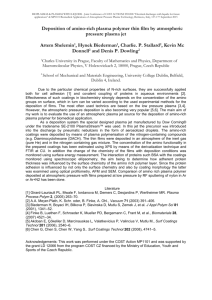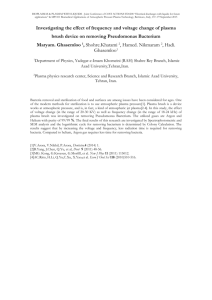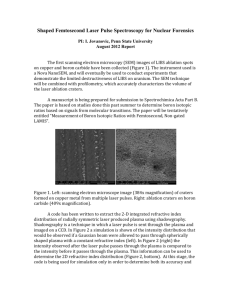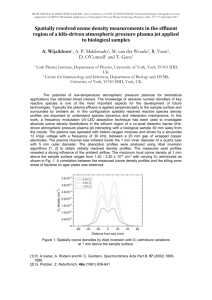Deliverable-21
advertisement
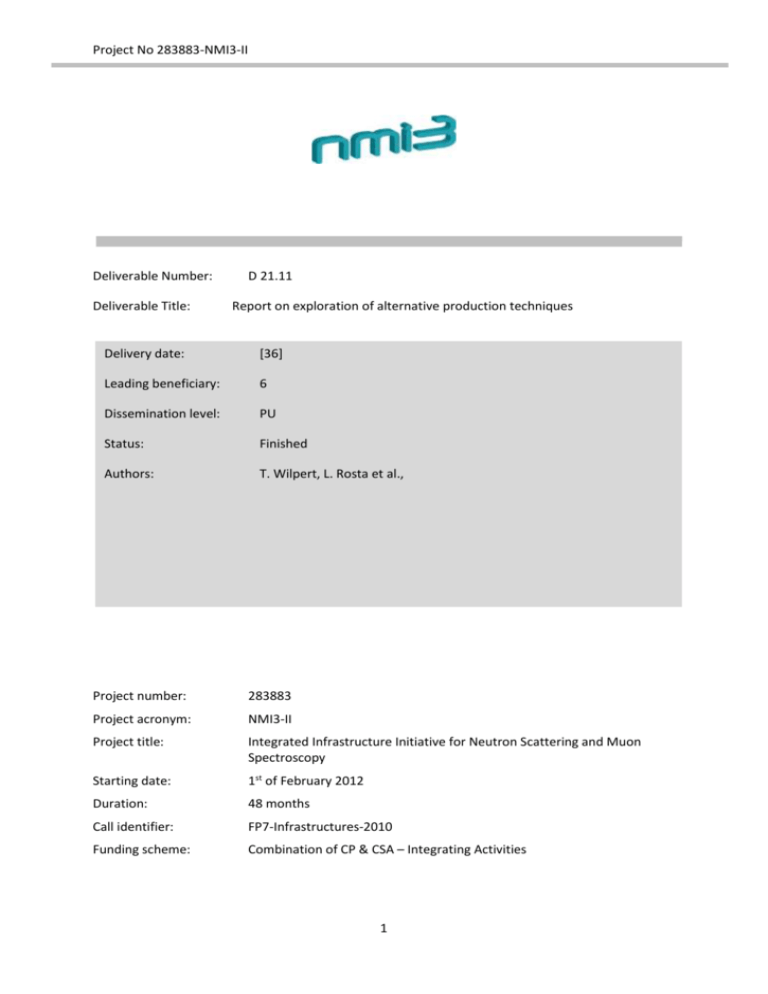
Project No 283883-NMI3-II Deliverable Number: Deliverable Title: D 21.11 Report on exploration of alternative production techniques Delivery date: [36] Leading beneficiary: 6 Dissemination level: PU Status: Finished Authors: T. Wilpert, L. Rosta et al., Project number: 283883 Project acronym: NMI3-II Project title: Integrated Infrastructure Initiative for Neutron Scattering and Muon Spectroscopy Starting date: 1st of February 2012 Duration: 48 months Call identifier: FP7-Infrastructures-2010 Funding scheme: Combination of CP & CSA – Integrating Activities 1 Description: Due to lack of Helium-3, the widely used standard neutron converter in thermal neutron detection, boron based thin layers have found their application in this field. The high conversion cross section of 10B for thermal neutrons has attracted attention for developing alternative, cost effective detectors. Especially detector systems for inelastic neutron scattering require large area (10 to 100 m2) detectors with stacks of 20-30 10B based layers of about 1 µm thickness. Formation of thin films for this application is associated with strict requirements on quality and uniformity of produced films. Currently, high quality neutron converters based on 10B4C (boron-10 carbide) solid films can be obtained by magnetron sputter deposition. In the current method the relatively high energy of particles, passed to the surface during condensation, strongly influences nucleation, growth and final film characteristics. However, the main disadvantages of magnetron sputtering are relatively low deposition rates of boron and higher final cost of coatings related to the use of vacuum conditions. Within the NMI3 Detector Joint Research Activity, the detector laboratory of HelmholtzZentrum Berlin studied different coating processes of 10B based thin film neutron converter deposition. At this time several fresh technologies appear on the market. Main efforts were focused on novel deposition technics which could increase the deposition rate and reduce the costs of boron layers while keeping their quality and long-term stability high. The following technologies with high potential for 10B based coatings were identified as promising: (i) a combination of inkjet method with plasma surface cleaning and activation, (ii) cold plasma deposition (like plasma assisted CVD), (iii) powder spray deposition with high temperature plasma torch. (i) Inkjet method with plasma surface cleaning and activation The inkjet method is well established for depositing (= printing) nano-sized dyes or color pigments on various materials and sizes of substrates. Dyes or color pigments are solved in liquid chemical compounds with a high vapor pressure which evaporates after printing. Thermal treatment of the substrates may be required in addition to reach the necessary purity of the boron layer. As main ingredient for neutron converters nano-size boron powder is required. A market analysis and requests to large suppliers of nanopowder (American Elements, Ceradyne, Sigma-Aldrich) showed that it is currently not possible to purchase enriched 10B nanopowder. Moreover, a delivered sample from a Chinese company turned out to contain no boron at all. Thus, for exploring the principle functionality of the method, natural material with grain size of 50 nm was purchased. In a first trial the Max-Planck-Institute for Colloids and Interfaces in Golm/Germany tried to produce boron ink by using different kind of solvents. However, no stable dispersion could be produced. In second trial boron ink was produced by company IOLITEC in Heilbronn/Germany as dispersion of boron nanopowder in two different solvents: water and ethylene glycol. 2 Homogenizing of the dispersions was achieved by ultrasonic treatment. After delivery it turned out that the water-based dispersion was not stable and has to be homogenized again prior to application. Silicon and aluminum substrates were cleaned and activated using APS (see III below) and immediately after coated by boron ink of both types by using airbrush technique. Unfortunately, under no circumstance a layer with acceptable homogeneity could be produced and further analyzed. The potential of plasma surface cleaning and activation with inkjet method is considered as low, since the formation of boron ink seems to be very delicate and would need an own intensive research. A premise for looking again in this technology is the availability of enriched 10B nanopowder. (ii) Cold plasma deposition Deposition by using a cold, i.e. room temperature plasma is a very fresh technology which allows high depositions rates on any size of area and even on 3D shaped substrates. Relatively low thermal load on the aluminum substrates which is favorable substrate material for large area neutron converters is an advantage. So far only few materials can be deposited. As ingredient a gaseous precursor is required, similar as in plasma assisted CVD. The main problem and obstacle for boron coatings is that only toxic precursors like ortho-carborane are available on the market. The potential of this technique is considered as low. It can be reconsidered in case suitable 10B-containing precursor become available. (iii) Powder spray deposition with high temperature atmospheric plasma torch After exhaustive analysis Atmospheric Pressure Plasma (APP) has been proposed as most promising alternative deposition technique to standard magnetron sputtering. Unlike vacuum plasma technologies, atmospheric plasma does not need complex vacuum equipment, can be applied – as in cold plasma deposition – to a wide variety of surfaces and could also provide high deposition rates. A detailed analysis of APP technologies, consultations with world leading experts in atmospheric plasma deposition and equipment tests showed that only spray deposition can be performed by using atmospheric pressure plasma. In this case micron-size powder, which is available on the market as enriched 10B and 10B4C powder with grains of 30-50 µm size is injected in the plasma and then delivered to the substrate by using a plasma torch. The main question connected to this method was the high melting temperature of boron powder which means that only a plasma sources with high plasma temperature can be used. Micron size boron powder must be evaporated in the plasma before being deposited to the substrate. Otherwise no homogenous boron layer with a thickness of ~1 µm would be created. After a detailed study of atmospheric pressure plasma sources and market analysis it was decided to create an experimental setup based on the microwave atmospheric plasma source produced by Muegge GmbH, Reichelsheim, Germany. The Microwave Atmospheric Plasma System (APS) which 3 has been assembled and applied for 10B coatings at Helmholtz-Zentrum Berlin within the NMI3 Detector Joint Research Activity is shown in Fig. 1. Fig. 1 Microwave Atmospheric Plasma System at Helmholtz-Zentrum Berlin After assembling the APS was tuned for better plasma ignition. In a next step different system parameters like microwave power, plasma gas flow, gas flow for boron particle injection, working distance between substrate and plasma outlet were studied and adjusted. Rather late it was found that the head of the plasma source had to be modified for powder injection as it is shown in the Fig. 2. Further improvements are possible if using FEM analysis tool for simulation of the gas flow and particle trajectories also in the plasma torch. 4 Fig. 2 Top part of Atmospheric Plasma Source for powder injection. Tests with injection of several types of microns size boron based powders (10B, 10B4C) into the microwave plasma torch have been performed. Inside the plasma source boron particles are evaporated and delivered to the substrate by atmospheric plasma torch. Thus, possibility of boron particles evaporation during the very short contact time of particles with the plasma has been proven as it is shown in Fig. 3. Fig. 3 Atmospheric Plasma jet before 10B powder injection (left) and during 10B powder injection (right) Different gas combinations for APS were tested, too. It was experimentally found that a suitable gas combination is compressed air as a working gas for atmospheric plasma torch and argon as a carrier gas for powder injection. In this case compressed air provides a stable 5 plasma torch without plasma filamentation and argon helps to reduce oxidation of boron in air environment. In addition, the optimal range of substrate temperatures for the boron-based layer formation has been found. Finally, boron based layers on silicon substrate were formed using APS with relatively high deposition rate of >100 nm/s (Fig. 4). The deposited layers were analyzed with Secondary Electron Microscopy (SEM) (Fig. 5). Silicon substrates had to be used for these tests because of their very smooth surface on the nanoscale. Fig.4 Boron-based coating on silicon deposited using Atmospheric Plasma System Fig.5. SEM image of boron-based coating on silicon deposited using APS However, unlike in magnetron sputtering the transfer of deposition parameters from silicon substrate to aluminum substrate is not straight forward. It was only in a few cases possible to 6 create a very thin boron layer on aluminum. The reproducibility of the process was low. Moreover, layers on aluminum were too thin and unstable so that no further analysis or tests in a detector were possible. High thermal load should be much more carefully balanced for these substrates to avoid corrugation or even melting of aluminum. The potential of this method is considered as high. More work has to be devoted to further optimization of operation parameters and possibly other pretreatment of aluminum substrates. A possible way is a coating with a nickel before the substrates is coated with boron. In quick tests an improvement in adhesion was observed by using Ni-coated substrates. Simultaneously nickel acts as a heat barrier and thus prevents melting of the Al substrate. A sufficient thick (~25 µm) nickel layer is anyway necessary in order to suppress background from radiation of alpha particles which are emitted from radioactive impurities contained in most natural aluminum. Appendix 1: The 2d test detector The 2D test detector has been designed specifically for the purpose of evaluating 10B4C layers produced in this task. This detector is similar to the test detector described in D21.12, but has been designed with 2D position sensitivity so that coating uniformity can be readily measured. The wire frames and delay lines for this detector have been built by BNC. The wire pitch of both the anode and cathode wires is 2 mm. The anode wires have a diameter of 10 μm and a mechanical tension of 18 g, while the cathode wires have a wire diameter of 30 μm and a mechanical tension of 60 g. The individual wire planes are shown in Figure 6 and the stacked array is shown in Figure 7. Fig.6. Individual anode and cathode wire frames for the 2D detector 7 Fig.7. The stack of wire frames for the 2D test detector Passive L-C delay lines have been mounted on the frames. The delay lines were tested electronically and the frames tested at high voltage before shipping them to HZB. The detector mechanics and assembly effort has been provided by HZB. The completed detector is shown in Figure 8. The boron converter can easily be exchanged and evaluated. Fig.8. The 2D test detector being assembled in the clean room at HZB HZB’s standard DeLiDAQ acquisition system for readout of 2D delay line detectors was used for data taking and analysis of measured data. 8 Appendix 2: Test results Unfortunately, test measurements with the produced converters were difficult to realize. FRM-II with a shared instrument for detector tests was shut down until August 2014 and BER-II with a dedicated detector test station was not running at all during the whole year 2014. Tests with neutron source were carried out at very low counting rates, but cannot deliver any useful number with respect to efficiency and homogeneity. Finally tests of produced 10B4C converters could be realized only end of November at the instrument TREFF at FRM-II. As substitution of converters created with HZB’s APS coating system, converters produced with magnetron sputtering were tested. Due to too high radiation background, Plexiglas could not be used for beam widening and thus efficiency for a 10 x 10 cm² converter had to be measured for selected spots. The result of these measurements is shown in Fig 9. Fig. 9 Absolute efficiency values measured for HZB’s 10B4C converter produced by magnetron sputtering. The measured values for efficiency are not as uniform as it was expected. The maximum deviation over an area of 100 cm² is in the order of 30%. However, it could be demonstrated that with this detector type and the DeLiDAQ data acquisition system future measurements and quality tests of converters can be performed much quicker. 9

